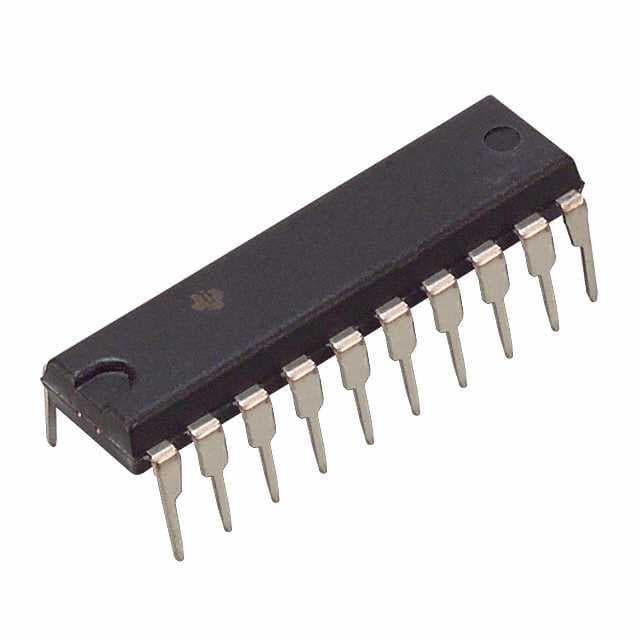SN74ABT373N
Product Overview
- Category: Integrated Circuit (IC)
- Use: Octal Transparent D-Type Latches with 3-State Outputs
- Characteristics:
- High-speed operation
- 3-state outputs for bus-oriented applications
- Non-inverting outputs
- Output sink capability of 64 mA, source capability of 32 mA
- Package: DIP (Dual In-line Package) or SOIC (Small Outline Integrated Circuit)
- Essence: The SN74ABT373N is a latch IC that can store and output data in an octal format. It is commonly used in digital systems where multiple bits of data need to be stored and accessed simultaneously.
- Packaging/Quantity: Available in tubes or reels, typically containing 25 or 250 units.
Specifications
- Supply voltage range: 4.5V to 5.5V
- Input voltage range: 0V to VCC
- Operating temperature range: -40°C to +85°C
- Output current: 64 mA (sink), 32 mA (source)
- Propagation delay time: 4.5 ns (max)
- Output capacitance: 10 pF (typ)
Detailed Pin Configuration
The SN74ABT373N has a total of 20 pins, which are assigned specific functions as follows:
- D0: Data input 0
- D1: Data input 1
- D2: Data input 2
- D3: Data input 3
- D4: Data input 4
- D5: Data input 5
- D6: Data input 6
- D7: Data input 7
- GND: Ground
- OE: Output enable
- CP: Clock pulse input
- LE: Latch enable
- Q0: Output 0
- Q1: Output 1
- Q2: Output 2
- Q3: Output 3
- Q4: Output 4
- Q5: Output 5
- Q6: Output 6
- Q7: Output 7
Functional Features
- Octal transparent latch with 3-state outputs
- Non-inverting outputs for easy integration into digital systems
- High-speed operation allows for efficient data storage and retrieval
- Output enable (OE) pin controls the output state, enabling bus-oriented applications
- Latch enable (LE) pin enables or disables the latching function
Advantages and Disadvantages
Advantages: - High-speed operation allows for quick data processing - 3-state outputs facilitate bus-oriented applications - Non-inverting outputs simplify system integration - Wide supply voltage range ensures compatibility with various systems
Disadvantages: - Limited output current capability compared to some other ICs - Requires external clock signal for proper operation - Not suitable for applications requiring high output capacitance
Working Principles
The SN74ABT373N operates as an octal transparent latch with 3-state outputs. When the latch enable (LE) input is high, the data inputs (D0-D7) are transferred to the corresponding outputs (Q0-Q7). The latch holds the data until a new set of inputs is provided.
The output enable (OE) input controls the output state. When OE is low, the outputs are in the high-impedance state, allowing multiple devices to share a common bus. When OE is high, the outputs reflect the stored data.
Detailed Application Field Plans
The SN74ABT373N is widely used in various digital systems, including but not limited to: - Microprocessors and microcontrollers - Data storage systems - Communication devices - Industrial control systems - Automotive electronics
Detailed and Complete Alternative Models
Some alternative models that offer similar functionality to the SN74ABT373N include: - 74HC373: Octal D-type transparent latch with 3-state outputs - CD74ACT373: Octal transparent latch with 3-state outputs - MC74ACT373: Octal D-type latch with 3-state outputs
These alternatives may have slightly different specifications or package options, but they serve the same purpose as the SN74ABT373N.
Word count: 531 words
Lista 10 Vanliga frågor och svar relaterade till tillämpningen av SN74ABT373N i tekniska lösningar
Sure! Here are 10 common questions and answers related to the application of SN74ABT373N in technical solutions:
Q: What is SN74ABT373N? A: SN74ABT373N is a type of octal transparent latch with 3-state outputs, commonly used in digital systems.
Q: What is the purpose of SN74ABT373N? A: SN74ABT373N is used to store and control the flow of data in digital circuits. It can latch and hold data until it is updated or released.
Q: How many bits can SN74ABT373N handle? A: SN74ABT373N is an octal latch, meaning it can handle 8 bits of data.
Q: What is the operating voltage range for SN74ABT373N? A: SN74ABT373N operates within a voltage range of 4.5V to 5.5V.
Q: Can SN74ABT373N be used in both synchronous and asynchronous applications? A: Yes, SN74ABT373N can be used in both synchronous and asynchronous applications, depending on the design requirements.
Q: What is the maximum clock frequency supported by SN74ABT373N? A: The maximum clock frequency supported by SN74ABT373N is typically around 200 MHz.
Q: Does SN74ABT373N have 3-state outputs? A: Yes, SN74ABT373N has 3-state outputs, which means it can be put into a high-impedance state to allow multiple devices to share a common bus.
Q: Can SN74ABT373N be cascaded to handle more than 8 bits of data? A: Yes, multiple SN74ABT373N latches can be cascaded together to handle larger data widths.
Q: What is the power consumption of SN74ABT373N? A: The power consumption of SN74ABT373N depends on various factors such as clock frequency and load capacitance, but it is generally low.
Q: Are there any specific precautions to consider when using SN74ABT373N? A: It is important to ensure proper decoupling capacitors are used near the power supply pins of SN74ABT373N to minimize noise and voltage fluctuations. Additionally, care should be taken to avoid exceeding the maximum ratings specified in the datasheet.
Please note that these answers are general and may vary depending on the specific application and design considerations. Always refer to the datasheet and consult with an expert for accurate information.


